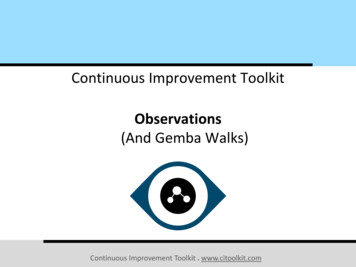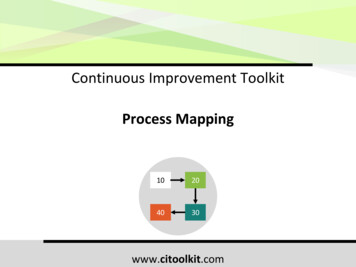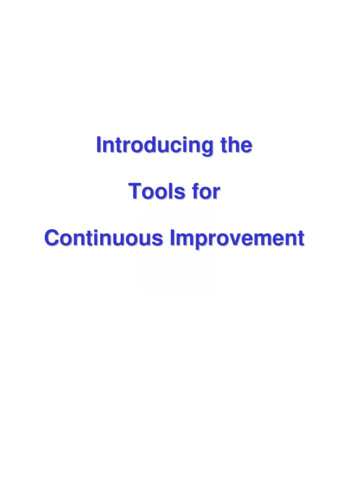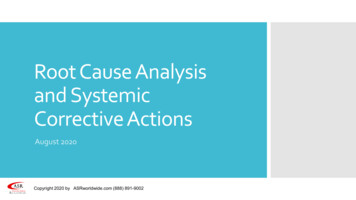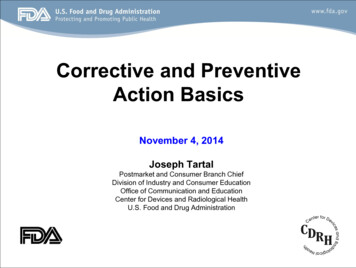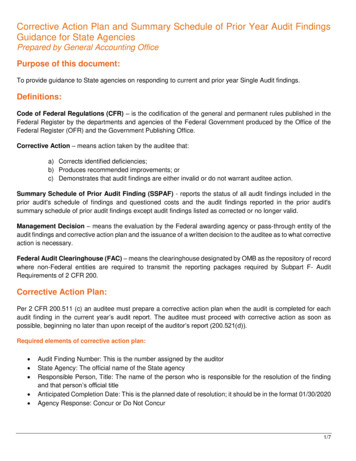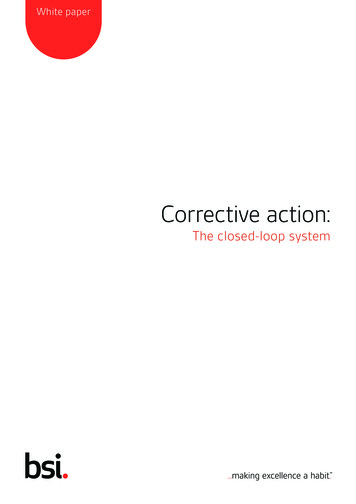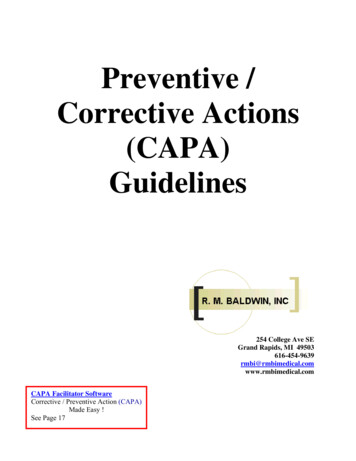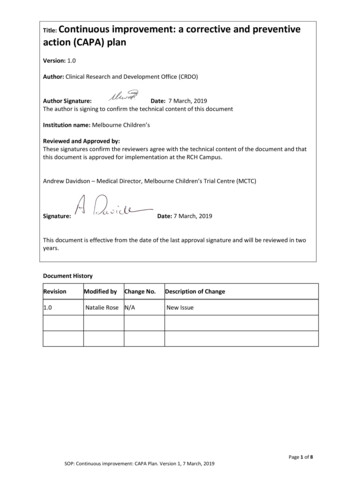
Transcription
Continuous improvement: a corrective and preventiveaction (CAPA) planTitle:Version: 1.0Author: Clinical Research and Development Office (CRDO)Author Signature:Date: 7 March, 2019The author is signing to confirm the technical content of this documentInstitution name: Melbourne Children’sReviewed and Approved by:These signatures confirm the reviewers agree with the technical content of the document and thatthis document is approved for implementation at the RCH Campus.Andrew Davidson – Medical Director, Melbourne Children’s Trial Centre (MCTC)Signature:Date: 7 March, 2019This document is effective from the date of the last approval signature and will be reviewed in twoyears.Document HistoryRevisionModified byChange No.1.0Natalie Rose N/ADescription of ChangeNew IssuePage 1 of 8SOP: Continuous improvement: CAPA Plan. Version 1, 7 March, 2019
Contents1.PURPOSE . 22.RESPONSIBILITY AND SCOPE . 23.APPLICABILITY . 24.BACKGROUND. 25.PROCEDURE . 25.1.Identification of an issue . 35.2.Assessing the risk – when is a CAPA required? . 35.3.Developing the CAPA plan . 35.4.Documenting and reporting the CAPA . 36.GLOSSARY . 57.REFERENCES . 58.APPENDICES . 61.PURPOSETo document the procedure for managing and addressing research-related risks as referredto in ICH E6 R2 section 5.20 and NHMRC’s 2018 “Guidance and supplementary guidance:safety monitoring and reporting in clinical trials involving therapeutic goods”, and “Reportingof Serious Breaches of Good Clinical Practice or the Protocol for Trials Involving TherapeuticGoods”.2.RESPONSIBILITY AND SCOPEThis standard applies to all Melbourne Children’s campus employees (including visitingmedical officers, visiting health professionals, contractors, consultants and volunteers) whopropose to undertake, administrate, review and/or govern human research involvingMelbourne Children’s research participants and staff.3.APPLICABILITYPrincipal Investigator/ Investigator, Sub-Investigator(s) research coordinators and otherstaff involved in trial-related duties for single site, RCH-based trials.4.BACKGROUNDA Corrective and Preventive Action Plan (CAPA) is a quality system plan used to address aresearch-related issue that has occurred. It incorporates:1. Identifying the root cause of the issue;2. Identifying actions to prevent recurrence of the issue (corrective action) or, identifyactions to prevent an issue from occurring (preventive action);3. Documenting that the required actions were completed.Some examples of research-related issues include: injury of clinical trial participants or a highpotential for this to occur; repeated violations of the protocol; serious breaches of privacyand significant data integrity problems.The CAPA process is an important part of ensuring quality and ethical research practice andensuring that systems used in research are continuously improved.5.PROCEDUREPage 2 of 8SOP: Continuous improvement: CAPA Plan. Version 1, 7 March, 2019
5.1. Identification of an issuePotential and/or actual issues that arise during the conduct of research can be identifiedthrough several sources. For example: A specific incident has occurred; Observations/concerns are made by a research staff member about a potentialissue; Concerns are raised during/after monitoring, auditing, external/third party audits,or regulatory authority inspection of the research; A concern raised by another body such as a data safety monitoring committee,HREC or Governance.Please note that these may or may not be a deviation from the protocol.5.2.Assessing the riskA CAPA is required in cases where a corrective action and/or preventive action is necessaryto appropriately address a risk. Risk assessments improve quality and compliance. They area proactive, anticipatory approach to improve quality management. The risk should bedetermined by assessing (i) the impact on patient rights/safety and the study objectives,and (ii) the likelihood of occurrence/recurrence.5.3. Developing the CAPA planThe steps involved are:1. Initiation of CAPA: The concerned department / individual shall identify and decidewho will take overall responsibility for the CAPA plan. This includes development of theCAPA plan, its implementation, training of staff on the CAPA plan, and evaluation ofthe results of the CAPA plan.2. Evaluate the extent of the problem: identify/characterise the problem; determine thescope and impact; investigate data, process, operations and other sources ofinformation; investigate the impact of the issue on the overall research.3. Focus on determining the root cause(s): investigate how/why the incident occurred(i.e. are there specific causes or sources of the problem; why is this problem occurring;is the problem due to training, design, manufacture, management, documentation,etc.)4. After identifying the root cause(s), break the solution into discrete, measurable actionsthat address the root cause(s) - actions items should include:a. What will be done – identify action(s) needed to correct and preventrecurrence (e.g. amending documents, changing systems, staff training)b. Who will make amendments/perform the corrective actions and when?c. Establishing an achievable target date for completion. Describe the proceduresimplemented to resolve the problem and indicate who is responsible for theprocedure. Indicate an achievable date for the corrective action.5. Track progress towards completion of all required actions and evaluate whether theimplemented actions have successfully addressed the issues.6. For Preventive Actions, describe the preventive actions or planned, and who isresponsible. Create a list of all tasks that must be completed to prevent the problem.5.4. Documenting and reporting the CAPACAPAs should be documented using the CAPA template (see attachment), unless theSponsor requires the use of their own template. Where the sponsor is not MCRI/RCH (i.e.Page 3 of 8SOP: Continuous improvement: CAPA Plan. Version 1, 7 March, 2019
commercial studies), a copy of the CAPA should be sent to the trial sponsor. Where MCRIacts as the sponsor, and an external coordinating centre is being used, the CAPA should besent to the external centre. Where MCRI is the sponsor, and coordinating centre, the CAPAshould be reviewed by the PI, and stored with other trial related documents in the TrialMaster File.Each issue requires a separate CAPA. All CAPAs should be reviewed, signed and dated bythe individual preparing the form and the Principal Investigator.The CAPA should be submitted to the appropriate authority or sponsor’s nominee within atimely fashion from identification of the issue, unless otherwise specified by the Sponsor.If the CAPA is required in response to a protocol deviation, a copy of the CAPA should besubmitted to the approving HREC and to RCH Governance Office, in accordance with theREG requirements for addressing protocol violations, deviations and complaints (pleaserefer to REG website for details).If the CAPA is unacceptable, the PI will be notified and will need to provide an appropriateresponse within the given timelines.A summary of all CAPAs (in progress and completed) should be maintained in a CAPAtracking log (see attachment), and stored with other trial related documents in the TrialMaster File. The CAPA Owner/Responsible Person must ensure that corrective and/orpreventive actions are managed, documented, completed, modified, verified as effective,and closed as required per this procedure.PROBLEM OCCURSIMMEDIATE CORRECTIONSASSESS RISKNoRiskSTOP:NoActionRequiredRiskROOT CAUSE ANALYSISPage 4 of 8SOP: Continuous improvement: CAPA Plan. Version 1, 7 March, 2019
CAPA PLAN(If CAPA didn’t resolve root cause)EFFECTIVENESS CHECK6.GLOSSARYCorrective and Preventive Action (CAPA) Plan – actions taken to collect information andidentify a problem, determine root cause, identify and implement a corrective and/orpreventive action to prevent further recurrence.CAPA Owner- Individual that ensures that a corrective and/ or preventive action(s) ismanaged, documented, completed, modified and verified as effective.Correction – immediate remedial actions taken to repair, rework or adjust the effect of anexisting deviation or other undesirable situation.Corrective Action – immediate action to a problem that has already occurred or has beenidentified.Preventive Action – taken to eliminate the root cause of a potential problem, including thedetection/identification of problems.Responsible Department – The area owner / management of dedicated equipment,facilities, personnel or processes.Responsible Person – Department or personnel accepting responsibility for the completionof assigned corrective and preventive actions.Root Cause – factor that caused a non-conformance and should be permanently eliminatedthrough process improvement.Root Cause Analysis – a class of problem solving methods used to identify the root causes ofproblems or events.7.REFERENCESNote for Guidance on Good Clinical Practice (CPMP/ICH/135/96, annotated with TGAcomments).RCH Research Ethics and Governance: Safety Report Form, August 2017.Page 5 of 8SOP: Continuous improvement: CAPA Plan. Version 1, 7 March, 2019
8.APPENDICESDOCUMENT ENDPage 6 of 8SOP: Continuous improvement: CAPA Plan. Version 1, 7 March, 2019
Appendix 1: Corrective and Preventive Action Plan TemplateA CAPA is written to identify a discrepancy/problem in the conduct of a clinical research study, note the rootcause of the identified problem, identify the corrective action to prevent the recurrence of the problem, anddocument that the corrective action has resolved the problem. In general, the tone of CAPA should beforward-looking and not seek to explain an error discovered in the conduct of a clinical research study.Date:Date that the CAPA is writtenTo:Sponsor, HREC, etcFrom (Person responsible foroverall CAPA):Name, Title, the site/institutional affiliation of the person authoring the CAPA,including their signatureProtocol Title / Research Study:HREC Number:Issue / Deficiency Identified:Brief description or outline of the topic/process/problem being documented. This canbe formatted as a paragraph, numbered list, or bulleted items.Root Cause:The reason(s) that the issue arose. Root-cause analysis is a class of problem solvingmethods used to identify the root causes of problems or events.Corrective Action Plan:Description of the correction action(s) taken or planned by the site. If the site wasinstructed to perform these corrective actions (i.e. by the sponsor or monitor), indicateby whom and as of what date. If status of reports, records or data will remainincomplete or unavailable, make a statement regarding your failed attempts ordescribe when/how the records will be retrieved or completed.Implementation:Description of the procedures used to document resolution of the problem, thepersons who are responsible for the procedures, etc.Effective Date of Resolution:Effective date for corrective actionPreventive Action:Description of the preventive actions taken or planned by the site. If the site wasinstructed to perform these preventive actions, indicate by whom and as of what date.Preventive actions are taken to eliminate the root-cause of a potential problem,including the detection/identification of problemsEvaluation/Follow up:Any plan/procedure to evaluate the implementation and completion, persons who areresponsible for the evaluations, timeframe for the evaluation, etc.Comments:Any additional comments or information not noted above. Document anyrelevant observations here.Principal Investigator SignatureDatePrincipal Investigator Printed NamePage 7 of 8SOP: Continuous improvement: CAPA Plan. Version 1, 7 March, 2019
Appendix 2: CAPA Tracking LogCORRECTIVE ACTIONREPORT NO.OPEN DATEISSUED TODESCRIPTIONDUE DATECLOSEOUTDATEVerified By:Date:Page 8 of 8SOP: Continuous improvement: CAPA Plan. Version 1, 7 March, 2019
the individual preparing the form and the Principal Investigator. The CAPA should be submitted to the appropriate authority or sponsor’s nominee within a timely fashion from identification of the issue, unless otherwise specified by the Sponsor. If the CAPA is required in response to a protocol deviation, a copy of the CAPA should be submitted to the approving HREC and to RCH Governance .
